Comprehensive Report: Human Nervous and Endocrine Systems
VerifiedAdded on 2021/06/14
|12
|2375
|238
Report
AI Summary
This report provides a comprehensive overview of the human nervous and endocrine systems. It begins by detailing the nervous system, including reflex arcs, neuron types (sensory, motor, and interneurons), and how neurons generate and propagate nerve impulses. The report then explains how synapses receive and relay nerve impulses. The second part of the report focuses on the endocrine system, describing the hormones produced by various glands (testosterone, aldosterone, growth hormone, and TSH) and their modes of action (steroid and water-soluble hormones). Finally, the report discusses positive and negative feedback mechanisms, providing examples such as childbirth and thyroxine hormone regulation, to illustrate how these systems maintain homeostasis. The document is contributed by a student to be published on the website Desklib, a platform which provides all the necessary AI based study tools for students.

Last Name 1
Human Nervous System & Endocrine System
By
Professors Name
Course code & Name
Date
Human Nervous System & Endocrine System
By
Professors Name
Course code & Name
Date
Paraphrase This Document
Need a fresh take? Get an instant paraphrase of this document with our AI Paraphraser
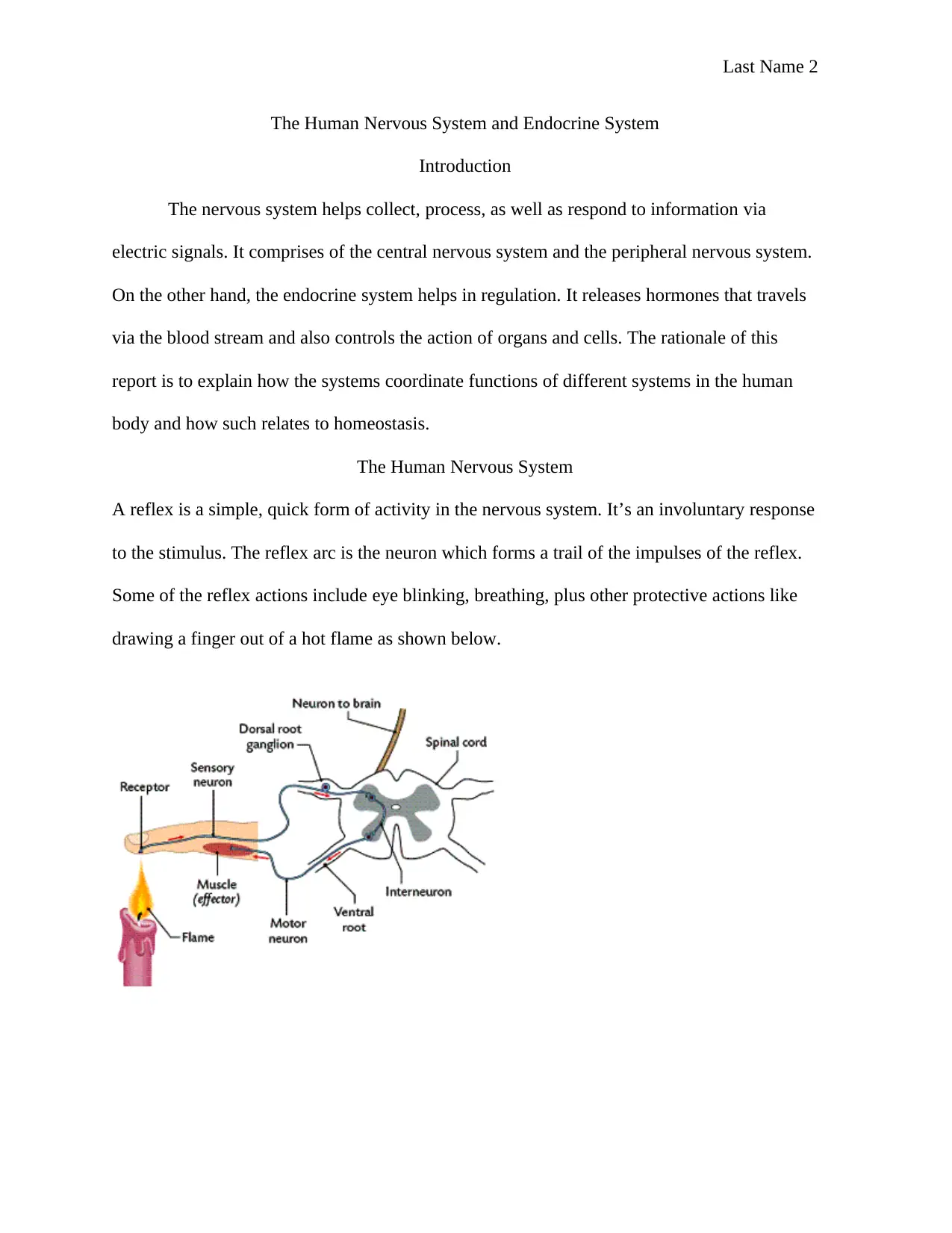
Last Name 2
The Human Nervous System and Endocrine System
Introduction
The nervous system helps collect, process, as well as respond to information via
electric signals. It comprises of the central nervous system and the peripheral nervous system.
On the other hand, the endocrine system helps in regulation. It releases hormones that travels
via the blood stream and also controls the action of organs and cells. The rationale of this
report is to explain how the systems coordinate functions of different systems in the human
body and how such relates to homeostasis.
The Human Nervous System
A reflex is a simple, quick form of activity in the nervous system. It’s an involuntary response
to the stimulus. The reflex arc is the neuron which forms a trail of the impulses of the reflex.
Some of the reflex actions include eye blinking, breathing, plus other protective actions like
drawing a finger out of a hot flame as shown below.
The Human Nervous System and Endocrine System
Introduction
The nervous system helps collect, process, as well as respond to information via
electric signals. It comprises of the central nervous system and the peripheral nervous system.
On the other hand, the endocrine system helps in regulation. It releases hormones that travels
via the blood stream and also controls the action of organs and cells. The rationale of this
report is to explain how the systems coordinate functions of different systems in the human
body and how such relates to homeostasis.
The Human Nervous System
A reflex is a simple, quick form of activity in the nervous system. It’s an involuntary response
to the stimulus. The reflex arc is the neuron which forms a trail of the impulses of the reflex.
Some of the reflex actions include eye blinking, breathing, plus other protective actions like
drawing a finger out of a hot flame as shown below.

Last Name 3
When a finger is drawn from a hot flame a withdrawal reflex is done. The stages of the reflex
action are as presented below. First, the finger is a receptor which has the sensory neurons
that transmit the impulses to the sensory nerves found in the dorsal root. Next the relay
transmits the impulses from the vertebral column to the motor neurons found in the ventral
root, where another neuron carries the impulse to the brain. A motor neuron carries the
impulses to the muscle where the finger is drawn away. Here, the impulses reach the brain
and a person feels the pain.
Types of Neurons.
A neuron is defined as a specialized cell within the cell body, the largest part which has
cytoplasm and nucleus. A majority of metabolic activity of the cell such as the production of
adenine triphosphate and production of proteins takes place in the cell body (Beloozerova,
Sirota & Swadlow, 2003, p.1087). The dendrites plus the entire cell body surface which are
the nerve cell receptive apparatus and also take impulses from the environment. The axon is
protected by an insulating sheath of myelin in animals without vertebral column as well as
some vertebrates and carries impulses from the cells body Neurons can take different shapes
depending on their location as well as function (Beloozerova, Sirota & Swadlow, 2003,
p.1087). The functional types of neurons are sensory neurons, motor neurons, and
When a finger is drawn from a hot flame a withdrawal reflex is done. The stages of the reflex
action are as presented below. First, the finger is a receptor which has the sensory neurons
that transmit the impulses to the sensory nerves found in the dorsal root. Next the relay
transmits the impulses from the vertebral column to the motor neurons found in the ventral
root, where another neuron carries the impulse to the brain. A motor neuron carries the
impulses to the muscle where the finger is drawn away. Here, the impulses reach the brain
and a person feels the pain.
Types of Neurons.
A neuron is defined as a specialized cell within the cell body, the largest part which has
cytoplasm and nucleus. A majority of metabolic activity of the cell such as the production of
adenine triphosphate and production of proteins takes place in the cell body (Beloozerova,
Sirota & Swadlow, 2003, p.1087). The dendrites plus the entire cell body surface which are
the nerve cell receptive apparatus and also take impulses from the environment. The axon is
protected by an insulating sheath of myelin in animals without vertebral column as well as
some vertebrates and carries impulses from the cells body Neurons can take different shapes
depending on their location as well as function (Beloozerova, Sirota & Swadlow, 2003,
p.1087). The functional types of neurons are sensory neurons, motor neurons, and
⊘ This is a preview!⊘
Do you want full access?
Subscribe today to unlock all pages.

Trusted by 1+ million students worldwide
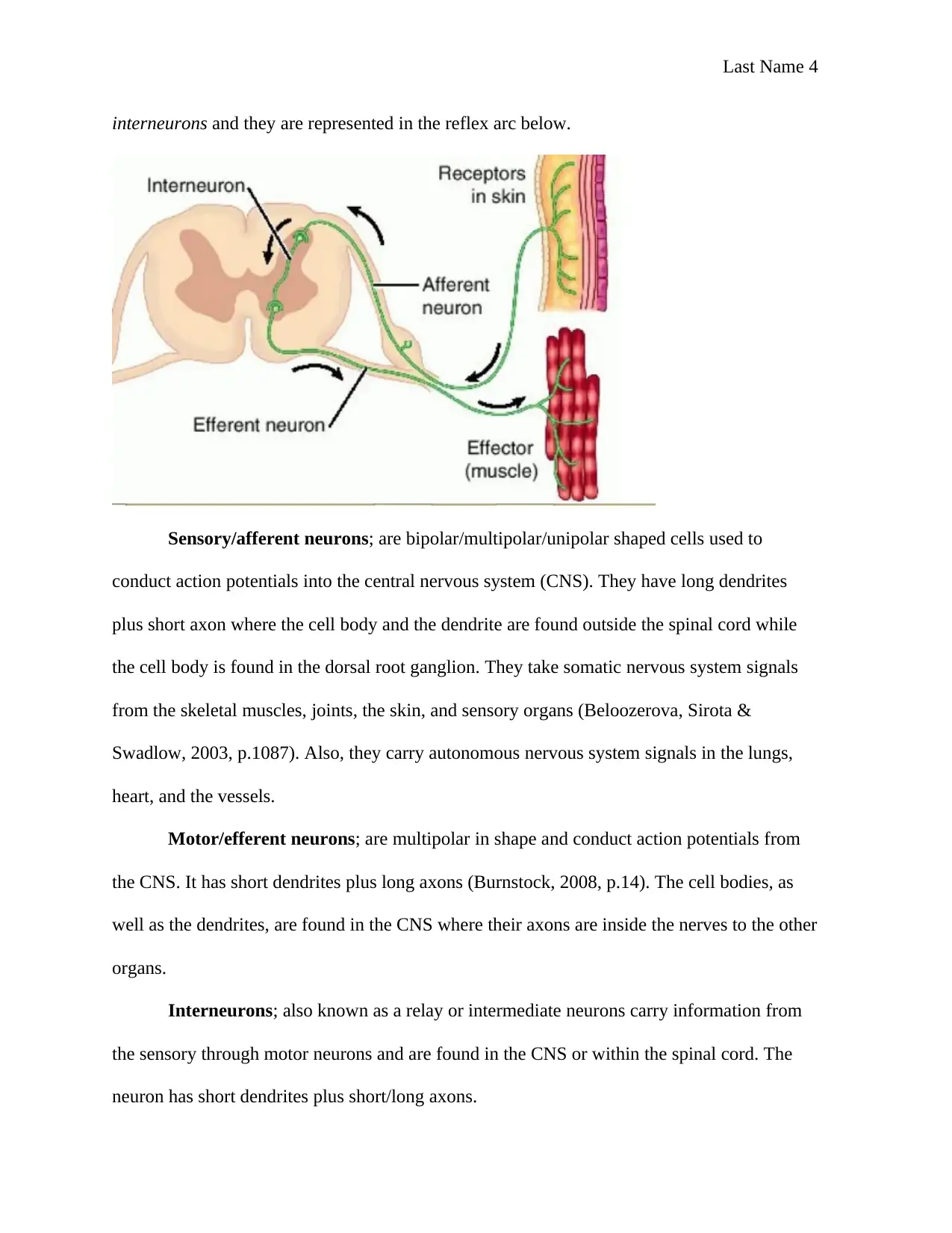
Last Name 4
interneurons and they are represented in the reflex arc below.
Sensory/afferent neurons; are bipolar/multipolar/unipolar shaped cells used to
conduct action potentials into the central nervous system (CNS). They have long dendrites
plus short axon where the cell body and the dendrite are found outside the spinal cord while
the cell body is found in the dorsal root ganglion. They take somatic nervous system signals
from the skeletal muscles, joints, the skin, and sensory organs (Beloozerova, Sirota &
Swadlow, 2003, p.1087). Also, they carry autonomous nervous system signals in the lungs,
heart, and the vessels.
Motor/efferent neurons; are multipolar in shape and conduct action potentials from
the CNS. It has short dendrites plus long axons (Burnstock, 2008, p.14). The cell bodies, as
well as the dendrites, are found in the CNS where their axons are inside the nerves to the other
organs.
Interneurons; also known as a relay or intermediate neurons carry information from
the sensory through motor neurons and are found in the CNS or within the spinal cord. The
neuron has short dendrites plus short/long axons.
interneurons and they are represented in the reflex arc below.
Sensory/afferent neurons; are bipolar/multipolar/unipolar shaped cells used to
conduct action potentials into the central nervous system (CNS). They have long dendrites
plus short axon where the cell body and the dendrite are found outside the spinal cord while
the cell body is found in the dorsal root ganglion. They take somatic nervous system signals
from the skeletal muscles, joints, the skin, and sensory organs (Beloozerova, Sirota &
Swadlow, 2003, p.1087). Also, they carry autonomous nervous system signals in the lungs,
heart, and the vessels.
Motor/efferent neurons; are multipolar in shape and conduct action potentials from
the CNS. It has short dendrites plus long axons (Burnstock, 2008, p.14). The cell bodies, as
well as the dendrites, are found in the CNS where their axons are inside the nerves to the other
organs.
Interneurons; also known as a relay or intermediate neurons carry information from
the sensory through motor neurons and are found in the CNS or within the spinal cord. The
neuron has short dendrites plus short/long axons.
Paraphrase This Document
Need a fresh take? Get an instant paraphrase of this document with our AI Paraphraser
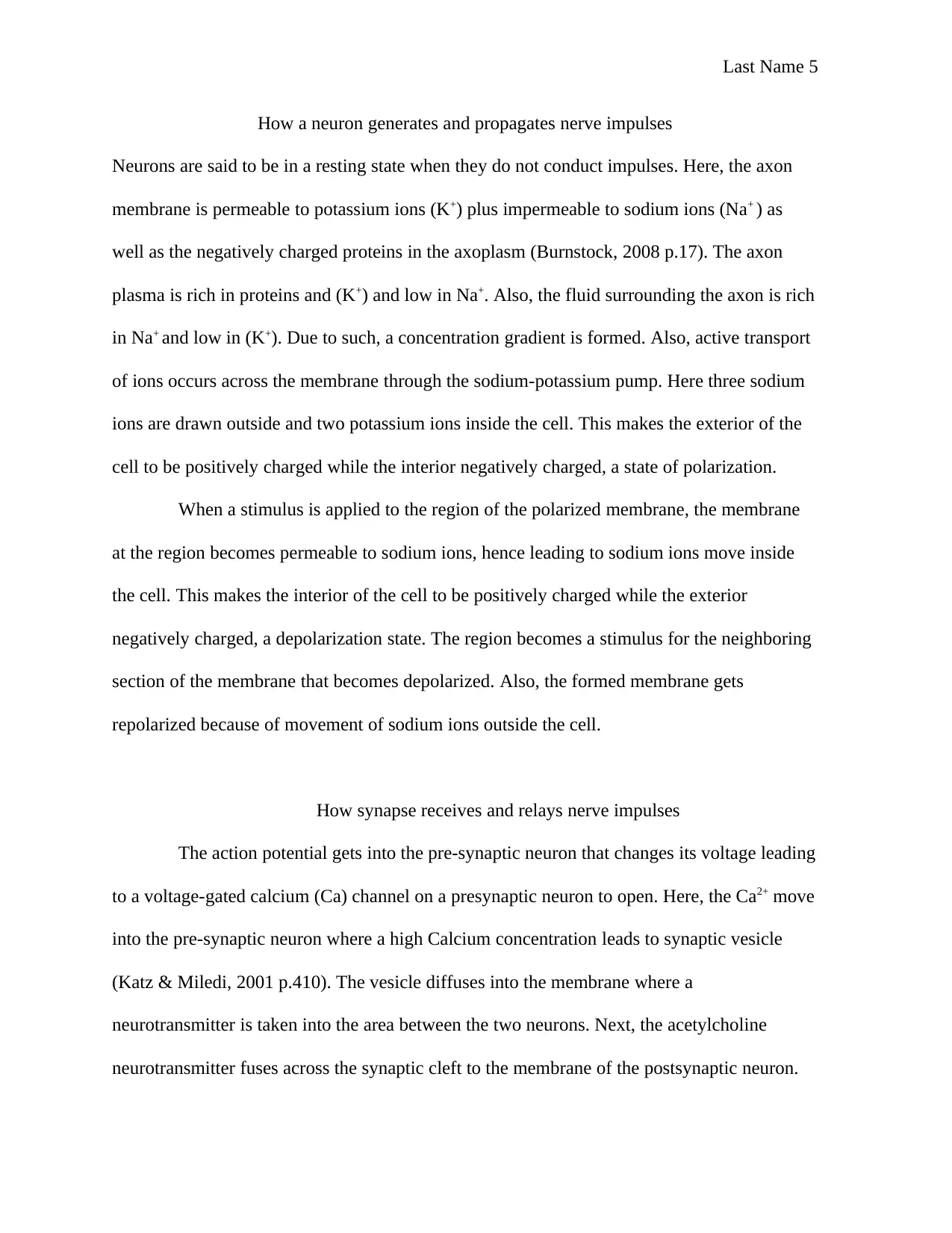
Last Name 5
How a neuron generates and propagates nerve impulses
Neurons are said to be in a resting state when they do not conduct impulses. Here, the axon
membrane is permeable to potassium ions (K+) plus impermeable to sodium ions (Na+ ) as
well as the negatively charged proteins in the axoplasm (Burnstock, 2008 p.17). The axon
plasma is rich in proteins and (K+) and low in Na+. Also, the fluid surrounding the axon is rich
in Na+ and low in (K+). Due to such, a concentration gradient is formed. Also, active transport
of ions occurs across the membrane through the sodium-potassium pump. Here three sodium
ions are drawn outside and two potassium ions inside the cell. This makes the exterior of the
cell to be positively charged while the interior negatively charged, a state of polarization.
When a stimulus is applied to the region of the polarized membrane, the membrane
at the region becomes permeable to sodium ions, hence leading to sodium ions move inside
the cell. This makes the interior of the cell to be positively charged while the exterior
negatively charged, a depolarization state. The region becomes a stimulus for the neighboring
section of the membrane that becomes depolarized. Also, the formed membrane gets
repolarized because of movement of sodium ions outside the cell.
How synapse receives and relays nerve impulses
The action potential gets into the pre-synaptic neuron that changes its voltage leading
to a voltage-gated calcium (Ca) channel on a presynaptic neuron to open. Here, the Ca2+ move
into the pre-synaptic neuron where a high Calcium concentration leads to synaptic vesicle
(Katz & Miledi, 2001 p.410). The vesicle diffuses into the membrane where a
neurotransmitter is taken into the area between the two neurons. Next, the acetylcholine
neurotransmitter fuses across the synaptic cleft to the membrane of the postsynaptic neuron.
How a neuron generates and propagates nerve impulses
Neurons are said to be in a resting state when they do not conduct impulses. Here, the axon
membrane is permeable to potassium ions (K+) plus impermeable to sodium ions (Na+ ) as
well as the negatively charged proteins in the axoplasm (Burnstock, 2008 p.17). The axon
plasma is rich in proteins and (K+) and low in Na+. Also, the fluid surrounding the axon is rich
in Na+ and low in (K+). Due to such, a concentration gradient is formed. Also, active transport
of ions occurs across the membrane through the sodium-potassium pump. Here three sodium
ions are drawn outside and two potassium ions inside the cell. This makes the exterior of the
cell to be positively charged while the interior negatively charged, a state of polarization.
When a stimulus is applied to the region of the polarized membrane, the membrane
at the region becomes permeable to sodium ions, hence leading to sodium ions move inside
the cell. This makes the interior of the cell to be positively charged while the exterior
negatively charged, a depolarization state. The region becomes a stimulus for the neighboring
section of the membrane that becomes depolarized. Also, the formed membrane gets
repolarized because of movement of sodium ions outside the cell.
How synapse receives and relays nerve impulses
The action potential gets into the pre-synaptic neuron that changes its voltage leading
to a voltage-gated calcium (Ca) channel on a presynaptic neuron to open. Here, the Ca2+ move
into the pre-synaptic neuron where a high Calcium concentration leads to synaptic vesicle
(Katz & Miledi, 2001 p.410). The vesicle diffuses into the membrane where a
neurotransmitter is taken into the area between the two neurons. Next, the acetylcholine
neurotransmitter fuses across the synaptic cleft to the membrane of the postsynaptic neuron.
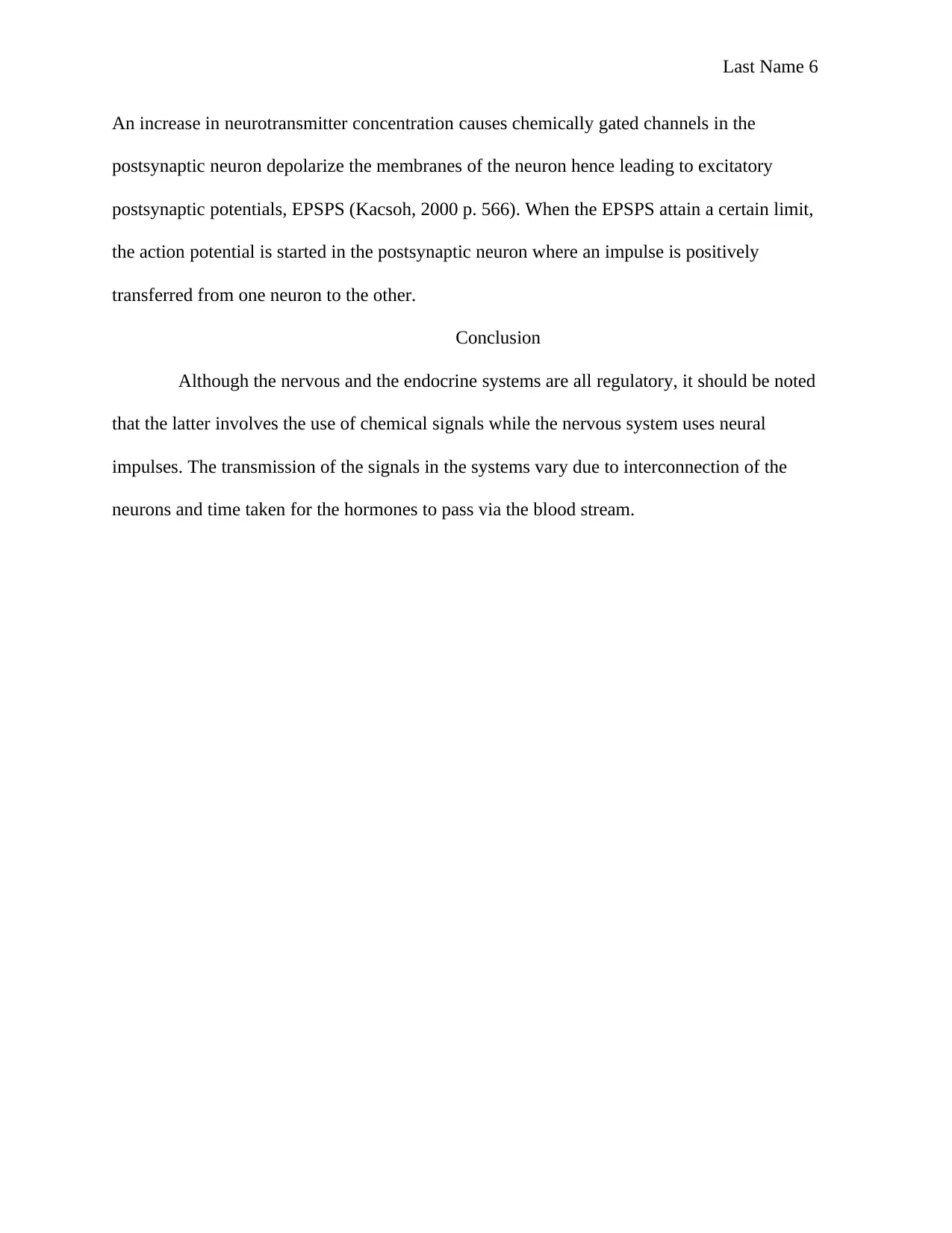
Last Name 6
An increase in neurotransmitter concentration causes chemically gated channels in the
postsynaptic neuron depolarize the membranes of the neuron hence leading to excitatory
postsynaptic potentials, EPSPS (Kacsoh, 2000 p. 566). When the EPSPS attain a certain limit,
the action potential is started in the postsynaptic neuron where an impulse is positively
transferred from one neuron to the other.
Conclusion
Although the nervous and the endocrine systems are all regulatory, it should be noted
that the latter involves the use of chemical signals while the nervous system uses neural
impulses. The transmission of the signals in the systems vary due to interconnection of the
neurons and time taken for the hormones to pass via the blood stream.
An increase in neurotransmitter concentration causes chemically gated channels in the
postsynaptic neuron depolarize the membranes of the neuron hence leading to excitatory
postsynaptic potentials, EPSPS (Kacsoh, 2000 p. 566). When the EPSPS attain a certain limit,
the action potential is started in the postsynaptic neuron where an impulse is positively
transferred from one neuron to the other.
Conclusion
Although the nervous and the endocrine systems are all regulatory, it should be noted
that the latter involves the use of chemical signals while the nervous system uses neural
impulses. The transmission of the signals in the systems vary due to interconnection of the
neurons and time taken for the hormones to pass via the blood stream.
⊘ This is a preview!⊘
Do you want full access?
Subscribe today to unlock all pages.

Trusted by 1+ million students worldwide
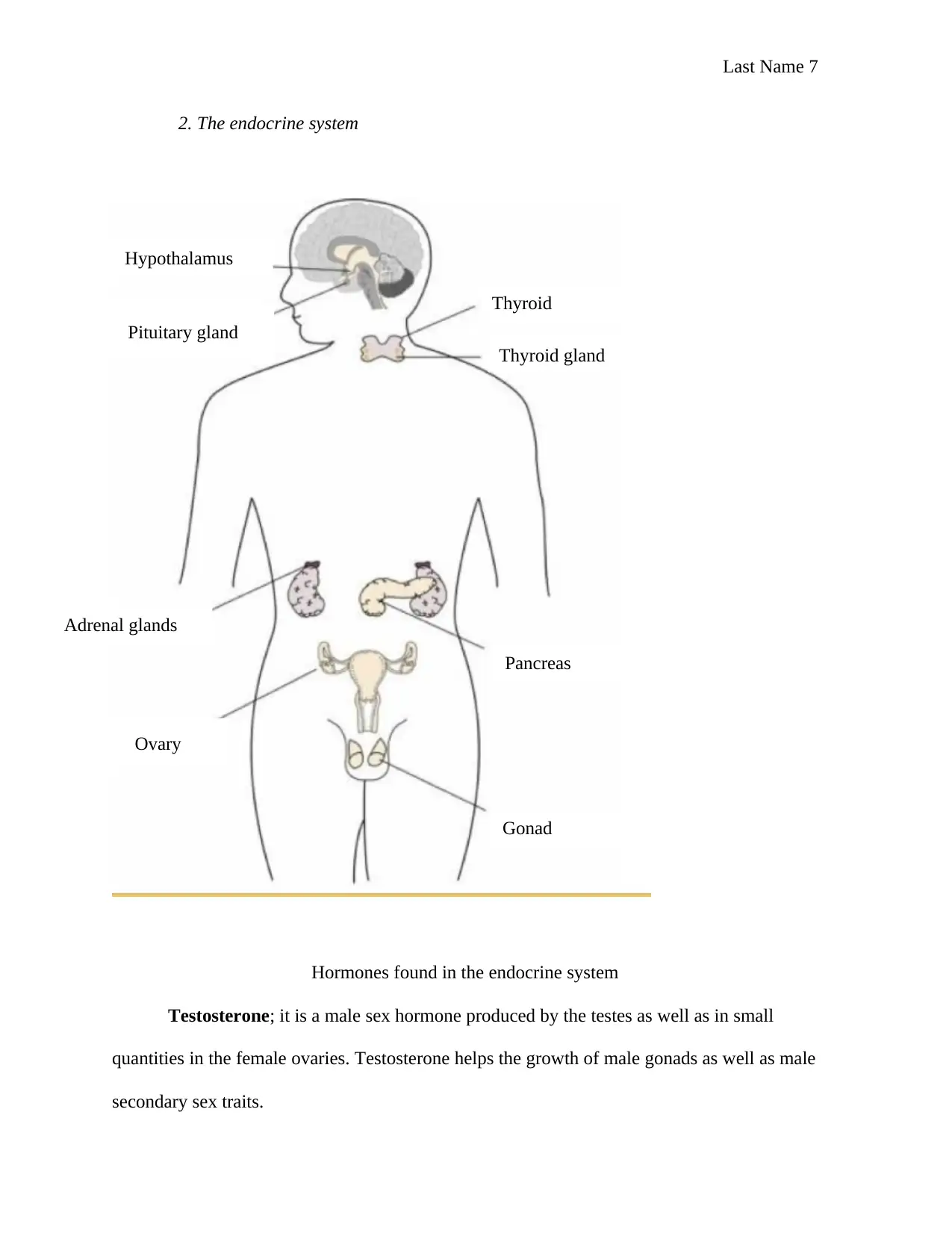
Last Name 7
2. The endocrine system
Hormones found in the endocrine system
Testosterone; it is a male sex hormone produced by the testes as well as in small
quantities in the female ovaries. Testosterone helps the growth of male gonads as well as male
secondary sex traits.
Hypothalamus
Pituitary gland
Thyroid
Thyroid gland
Adrenal glands
Pancreas
Gonad
Ovary
2. The endocrine system
Hormones found in the endocrine system
Testosterone; it is a male sex hormone produced by the testes as well as in small
quantities in the female ovaries. Testosterone helps the growth of male gonads as well as male
secondary sex traits.
Hypothalamus
Pituitary gland
Thyroid
Thyroid gland
Adrenal glands
Pancreas
Gonad
Ovary
Paraphrase This Document
Need a fresh take? Get an instant paraphrase of this document with our AI Paraphraser

Last Name 8
Aldosterone; it is an adrenal gland hormone that helps in blood pressure regulations
through raising blood pressure as well as volume.
Growth hormone; stimulates the growth of bones plus tissues and also the emotional
wellness of a person.
Thyroid stimulating hormone (TSH); helps the thyroid gland to give thyroid
hormones
Mode of action of a steroid hormone
Steroid hormones leads to changes in a cell by passing via the plasma membrane of
the target cell. They achieve this since they are soluble in fats. The plasma membrane
comprises of a phospholipid bilayer that averts fat insoluble compounds from spreading into a
cell (Kloosterboer, 2001 p.235). When inside the cell, the hormones bind with a receptor in
the cytoplasm of a target cell and then travels into the nucleus. Here it binds to a different
receptor on the chromatin. Once in the chromatin, the steroid hormone receptor complex calls
for the synthesis of RNA molecules by transcription (Nieuwenhuys, Voogd, &Van, 2007).
The molecules are changed as well as moved to the cytoplasm. The mRNA molecules then
code for the synthesis of proteins via translation.
Mode of action of a water soluble hormone.
The hormone molecule attaches to the receptor molecules extending from the edge of
the target cell. Attachment of the hormone to the receptor causes a chemical reaction inside
the cell without a hormone molecule entering the cell (Marieb, & Hoehn, 2004 p.610). Next,
the chemical reaction activates the enzymes inside the cell and then change the biochemical
action of the cells such that the rate of activities executed by the cell is decreased or increased
Aldosterone; it is an adrenal gland hormone that helps in blood pressure regulations
through raising blood pressure as well as volume.
Growth hormone; stimulates the growth of bones plus tissues and also the emotional
wellness of a person.
Thyroid stimulating hormone (TSH); helps the thyroid gland to give thyroid
hormones
Mode of action of a steroid hormone
Steroid hormones leads to changes in a cell by passing via the plasma membrane of
the target cell. They achieve this since they are soluble in fats. The plasma membrane
comprises of a phospholipid bilayer that averts fat insoluble compounds from spreading into a
cell (Kloosterboer, 2001 p.235). When inside the cell, the hormones bind with a receptor in
the cytoplasm of a target cell and then travels into the nucleus. Here it binds to a different
receptor on the chromatin. Once in the chromatin, the steroid hormone receptor complex calls
for the synthesis of RNA molecules by transcription (Nieuwenhuys, Voogd, &Van, 2007).
The molecules are changed as well as moved to the cytoplasm. The mRNA molecules then
code for the synthesis of proteins via translation.
Mode of action of a water soluble hormone.
The hormone molecule attaches to the receptor molecules extending from the edge of
the target cell. Attachment of the hormone to the receptor causes a chemical reaction inside
the cell without a hormone molecule entering the cell (Marieb, & Hoehn, 2004 p.610). Next,
the chemical reaction activates the enzymes inside the cell and then change the biochemical
action of the cells such that the rate of activities executed by the cell is decreased or increased

Last Name 9
(Westenbroek, Hoskins, & Catterall, 2008). That is to say, some processes occur very quick or
slow because of the instruction a cell receives by the binding of the hormone to a receptor.
3. Examples of negative feedback and positive feedback
Positive feedback; is when production of a reaction leads to an increase in that
reaction. For a system, in homeostasis, the positive feedback shifts the system far from the
equilibrium target (Cannon &Rosenblueth 2007). It amplifies the effects of the product plus
occurs when an event has to happen suddenly. Examples of positive feedback include fruit
ripening, childbirth, and blood clotting.
Negative feedback; the sensory cells in the body of the animal with vertebral column
helps monitor the reference area of the internal environment. Changes in the internal
environment can trigger, the receptor cells that relay information to the control center
(Cannon &Rosenblueth 2007). The latter determines the deviation as well as activates the
effectors which respond to the stimulus plus correct the reference area by
increasing/decreasing its activation. Immediately the system is corrected, the effectors plus
the control center are switched off. In negative feedback mechanism, changes occurring in a
system automatically triggers the corrective mechanism, which reverses the changes and
brings the system to normal (Harris & Levine, 2005). Examples of negative feedback
mechanism include regulation of thyroxine hormone, blood pressure, blood sugar and PH.
Mechanisms of positive and negative feedback
Childbirth (positive feedback); when labor starts a baby’s head is moved
downwards thus resulting much pressure on the cervix hence triggering receptor cells to relay
(Westenbroek, Hoskins, & Catterall, 2008). That is to say, some processes occur very quick or
slow because of the instruction a cell receives by the binding of the hormone to a receptor.
3. Examples of negative feedback and positive feedback
Positive feedback; is when production of a reaction leads to an increase in that
reaction. For a system, in homeostasis, the positive feedback shifts the system far from the
equilibrium target (Cannon &Rosenblueth 2007). It amplifies the effects of the product plus
occurs when an event has to happen suddenly. Examples of positive feedback include fruit
ripening, childbirth, and blood clotting.
Negative feedback; the sensory cells in the body of the animal with vertebral column
helps monitor the reference area of the internal environment. Changes in the internal
environment can trigger, the receptor cells that relay information to the control center
(Cannon &Rosenblueth 2007). The latter determines the deviation as well as activates the
effectors which respond to the stimulus plus correct the reference area by
increasing/decreasing its activation. Immediately the system is corrected, the effectors plus
the control center are switched off. In negative feedback mechanism, changes occurring in a
system automatically triggers the corrective mechanism, which reverses the changes and
brings the system to normal (Harris & Levine, 2005). Examples of negative feedback
mechanism include regulation of thyroxine hormone, blood pressure, blood sugar and PH.
Mechanisms of positive and negative feedback
Childbirth (positive feedback); when labor starts a baby’s head is moved
downwards thus resulting much pressure on the cervix hence triggering receptor cells to relay
⊘ This is a preview!⊘
Do you want full access?
Subscribe today to unlock all pages.

Trusted by 1+ million students worldwide
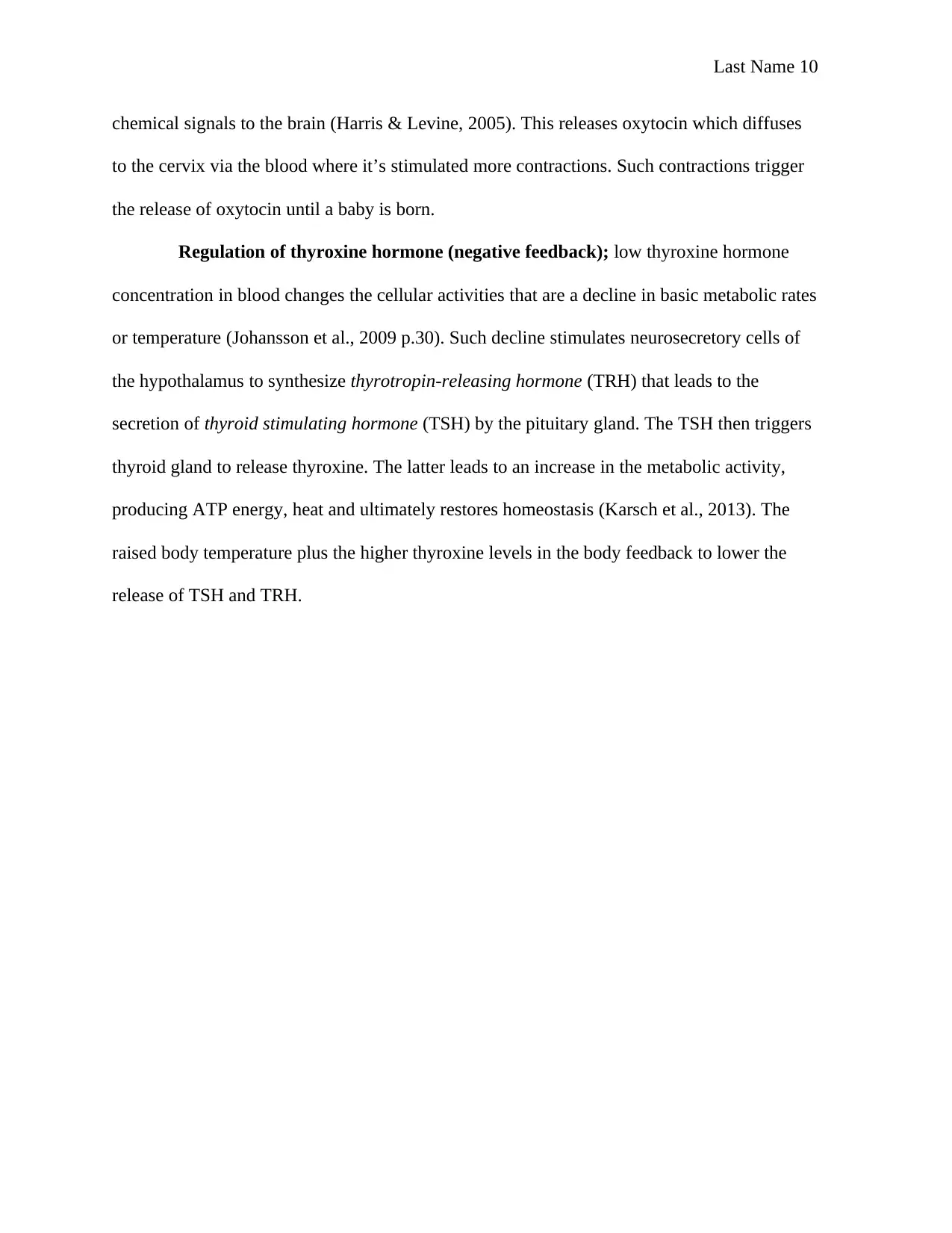
Last Name 10
chemical signals to the brain (Harris & Levine, 2005). This releases oxytocin which diffuses
to the cervix via the blood where it’s stimulated more contractions. Such contractions trigger
the release of oxytocin until a baby is born.
Regulation of thyroxine hormone (negative feedback); low thyroxine hormone
concentration in blood changes the cellular activities that are a decline in basic metabolic rates
or temperature (Johansson et al., 2009 p.30). Such decline stimulates neurosecretory cells of
the hypothalamus to synthesize thyrotropin-releasing hormone (TRH) that leads to the
secretion of thyroid stimulating hormone (TSH) by the pituitary gland. The TSH then triggers
thyroid gland to release thyroxine. The latter leads to an increase in the metabolic activity,
producing ATP energy, heat and ultimately restores homeostasis (Karsch et al., 2013). The
raised body temperature plus the higher thyroxine levels in the body feedback to lower the
release of TSH and TRH.
chemical signals to the brain (Harris & Levine, 2005). This releases oxytocin which diffuses
to the cervix via the blood where it’s stimulated more contractions. Such contractions trigger
the release of oxytocin until a baby is born.
Regulation of thyroxine hormone (negative feedback); low thyroxine hormone
concentration in blood changes the cellular activities that are a decline in basic metabolic rates
or temperature (Johansson et al., 2009 p.30). Such decline stimulates neurosecretory cells of
the hypothalamus to synthesize thyrotropin-releasing hormone (TRH) that leads to the
secretion of thyroid stimulating hormone (TSH) by the pituitary gland. The TSH then triggers
thyroid gland to release thyroxine. The latter leads to an increase in the metabolic activity,
producing ATP energy, heat and ultimately restores homeostasis (Karsch et al., 2013). The
raised body temperature plus the higher thyroxine levels in the body feedback to lower the
release of TSH and TRH.
Paraphrase This Document
Need a fresh take? Get an instant paraphrase of this document with our AI Paraphraser
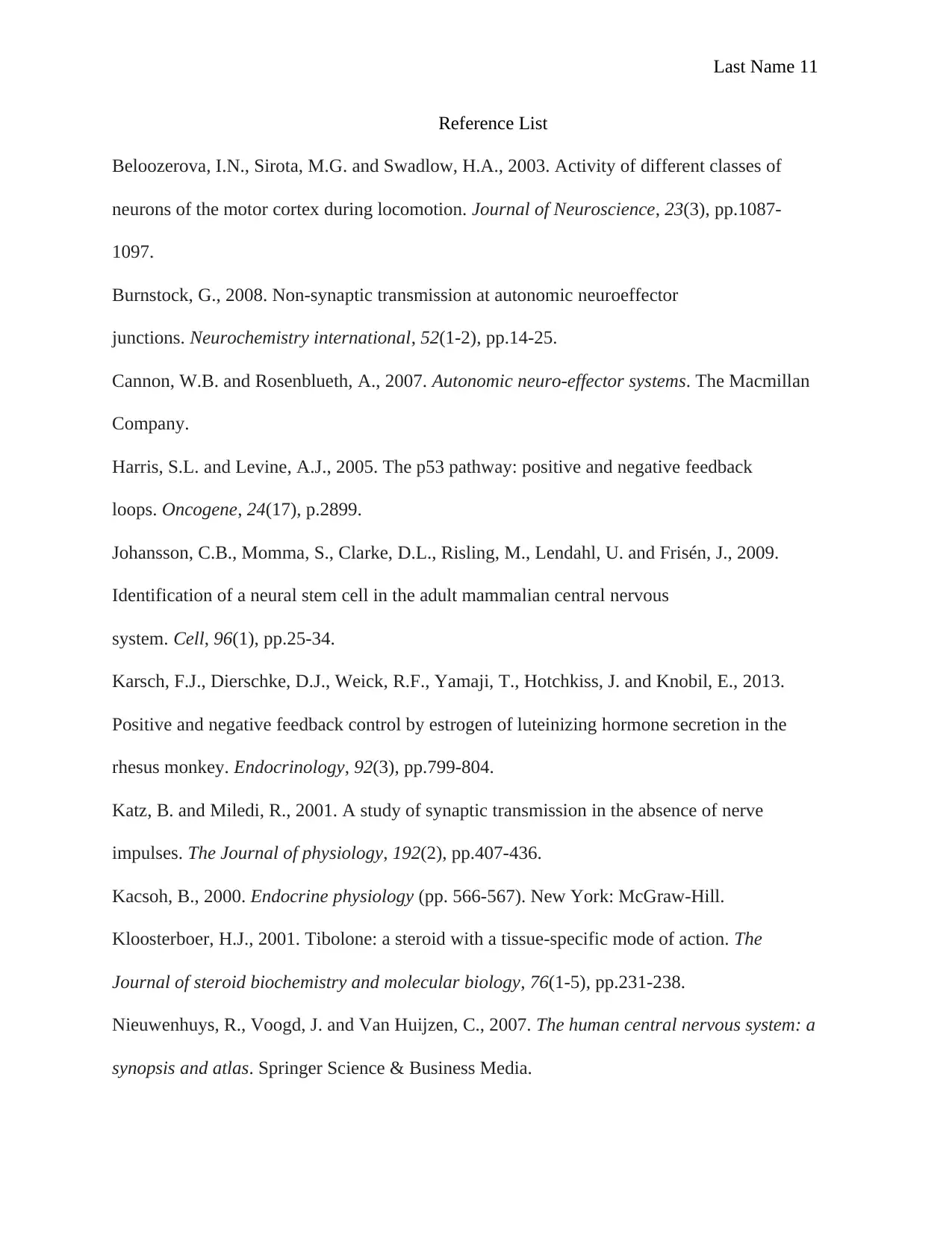
Last Name 11
Reference List
Beloozerova, I.N., Sirota, M.G. and Swadlow, H.A., 2003. Activity of different classes of
neurons of the motor cortex during locomotion. Journal of Neuroscience, 23(3), pp.1087-
1097.
Burnstock, G., 2008. Non-synaptic transmission at autonomic neuroeffector
junctions. Neurochemistry international, 52(1-2), pp.14-25.
Cannon, W.B. and Rosenblueth, A., 2007. Autonomic neuro-effector systems. The Macmillan
Company.
Harris, S.L. and Levine, A.J., 2005. The p53 pathway: positive and negative feedback
loops. Oncogene, 24(17), p.2899.
Johansson, C.B., Momma, S., Clarke, D.L., Risling, M., Lendahl, U. and Frisén, J., 2009.
Identification of a neural stem cell in the adult mammalian central nervous
system. Cell, 96(1), pp.25-34.
Karsch, F.J., Dierschke, D.J., Weick, R.F., Yamaji, T., Hotchkiss, J. and Knobil, E., 2013.
Positive and negative feedback control by estrogen of luteinizing hormone secretion in the
rhesus monkey. Endocrinology, 92(3), pp.799-804.
Katz, B. and Miledi, R., 2001. A study of synaptic transmission in the absence of nerve
impulses. The Journal of physiology, 192(2), pp.407-436.
Kacsoh, B., 2000. Endocrine physiology (pp. 566-567). New York: McGraw-Hill.
Kloosterboer, H.J., 2001. Tibolone: a steroid with a tissue-specific mode of action. The
Journal of steroid biochemistry and molecular biology, 76(1-5), pp.231-238.
Nieuwenhuys, R., Voogd, J. and Van Huijzen, C., 2007. The human central nervous system: a
synopsis and atlas. Springer Science & Business Media.
Reference List
Beloozerova, I.N., Sirota, M.G. and Swadlow, H.A., 2003. Activity of different classes of
neurons of the motor cortex during locomotion. Journal of Neuroscience, 23(3), pp.1087-
1097.
Burnstock, G., 2008. Non-synaptic transmission at autonomic neuroeffector
junctions. Neurochemistry international, 52(1-2), pp.14-25.
Cannon, W.B. and Rosenblueth, A., 2007. Autonomic neuro-effector systems. The Macmillan
Company.
Harris, S.L. and Levine, A.J., 2005. The p53 pathway: positive and negative feedback
loops. Oncogene, 24(17), p.2899.
Johansson, C.B., Momma, S., Clarke, D.L., Risling, M., Lendahl, U. and Frisén, J., 2009.
Identification of a neural stem cell in the adult mammalian central nervous
system. Cell, 96(1), pp.25-34.
Karsch, F.J., Dierschke, D.J., Weick, R.F., Yamaji, T., Hotchkiss, J. and Knobil, E., 2013.
Positive and negative feedback control by estrogen of luteinizing hormone secretion in the
rhesus monkey. Endocrinology, 92(3), pp.799-804.
Katz, B. and Miledi, R., 2001. A study of synaptic transmission in the absence of nerve
impulses. The Journal of physiology, 192(2), pp.407-436.
Kacsoh, B., 2000. Endocrine physiology (pp. 566-567). New York: McGraw-Hill.
Kloosterboer, H.J., 2001. Tibolone: a steroid with a tissue-specific mode of action. The
Journal of steroid biochemistry and molecular biology, 76(1-5), pp.231-238.
Nieuwenhuys, R., Voogd, J. and Van Huijzen, C., 2007. The human central nervous system: a
synopsis and atlas. Springer Science & Business Media.

Last Name 12
Marieb, E.N. and Hoehn, K., 2004. The endocrine system. Human Anatomy & Physiology,
pp.603-643.
Westenbroek, R.E., Hoskins, L. and Catterall, W.A., 2008. Localization of Ca2+ channel
subtypes on rat spinal motor neurons, interneurons, and nerve terminals. Journal of
Neuroscience, 18(16), pp.6319-6330.
Marieb, E.N. and Hoehn, K., 2004. The endocrine system. Human Anatomy & Physiology,
pp.603-643.
Westenbroek, R.E., Hoskins, L. and Catterall, W.A., 2008. Localization of Ca2+ channel
subtypes on rat spinal motor neurons, interneurons, and nerve terminals. Journal of
Neuroscience, 18(16), pp.6319-6330.
⊘ This is a preview!⊘
Do you want full access?
Subscribe today to unlock all pages.

Trusted by 1+ million students worldwide
1 out of 12
Related Documents
Your All-in-One AI-Powered Toolkit for Academic Success.
+13062052269
info@desklib.com
Available 24*7 on WhatsApp / Email
![[object Object]](/_next/static/media/star-bottom.7253800d.svg)
Unlock your academic potential
Copyright © 2020–2025 A2Z Services. All Rights Reserved. Developed and managed by ZUCOL.





